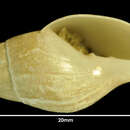fi
nimet breadcrumb-navigoinnissa


“Proximitra banksi. n.sp. (Plate 1, fig. 7)
Shell of medium size, fusiform, apparently highly polished in life. Whorls 6, apex eroded. Spire whorls lightly convex, body whorl slightly swollen, regularly contracted across base. Suture impressed. Post nuclear sculpture consisting of irregular fine incised spirals and fine irregular growth lines. There are signs of stronger impressed spirals across the base. Aperture slightly oblique, dilated, narrowly ovate, produced below into short canal. Outer lip broken. Columella bearing three strong folds with a very weak fold below. Upper two folds almost horizontal.
In addition to the above worn specimen there was also a fresh broken apical portion of a shell which is almost certainly referable to this species. The protoconch is not differentiated noticeably from the early whorls but would appear to consist of 4½ whorls. The first one and a half whorls rather bulbous and smooth, the rest sculptured with fine incised spirals and fairly numerous fine axials, both series becoming stronger over the next two whorls and becoming obsolete over the first post nuclear whorl.
Height 32.3 mm. (minus apex), diameter 14.5 mm.
This species appears to belong to the same group as the northern P. obscura Hutton. The general habit and above all the structure and arrangement of the columellar folds agrees very closely in the two species. P. banksi is considerably larger and lacks the axial sculpture of obscura. The relationship between these two species and the Tertiary species grouped around rutidolomum Suter to which latter the name, Proximitra strictly applies will only be determined by critical study of well preserved apices.
Holotype and two other broken shells in the collection of the Canterbury Museum.”
(Dell, 1951: 54-55)